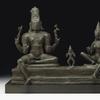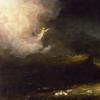Science, nature, and art merge in Integrated Vision at de Cordova
- LINCOLN, Massachusetts
- /
- April 12, 2015
DeCordova Sculpture Park and Museum will present Integrated Vision: Science, Nature, and Abstraction in the Art of Len Gittleman and György Kepes. This exhibition of permanent collection work brings together highly textured, luminously pigmentedpaintings by György Kepes and bold, graphic screen prints by Len Gittleman to create a dialogue aboutscience, nature, and art. Integrated Vision opens May 9, 2015, and will be on view in the James and Audrey Foster Galleries through September 6, 2015.
Writing about people’s inability to fully grasp the infinite knowledge available in the world–particularly in light of modern scientific advances–Kepes called for an “integrated vision.” By that, hemeant a vision that assimilated rational and emotional experience. Presented together in IntegratedVision, works by Kepes and Gittleman create a conversation about the artist’s role in examining andinterpreting empirical knowledge of science and nature through the lens of art.
Gittleman’s Lunar Transformation is a series of ten vividly colored serigraphs created from black andwhite photographs taken during the Apollo 15 mission to the moon in 1971. Gittleman uses brightcolor to transform the craters and crevices of the lunar surface into vibrant abstractions which recallAbstract Expressionist painting. The strong graphic prints reflect the awe-inspiring nature of theirsource material.
Best known for his photography, design, and writings about the marriage of art and science, Kepes wasalso a prolific painter. His paintings served as a vehicle for exploration of the relationship betweenstructural and gestural marks, terrestrial and celestial allusions, and physical and metaphysicalexperiences. While abstract, the earthy texture and biomorphic shapes in Kepes’ paintings hint atlandscapes, cosmic bodies, or amoebic forms.
Photographs by each artist will also be included to provide context for the serigraphs and paintings inrelationship to the artists’ larger practices. Gittleman’s Polaroid photograms, like his serigraphs, usecolor and light to render abstract forms. Striking illusions of three-dimensionality appear in theseimages, which present a strong formal arrangement of shape, color, and shadow. Kepes’ photographsreveal a clear correlation with his paintings: both combine expressive lines and atmospheric lightingeffects, reflecting his study of the intersection of science, art, and nature.
Len Gittleman (born 1932) is a photographer, illustrator, and filmmaker living in Watertown, Massachusetts. He attended the Institute of Design in Chicago, originally called The New Bauhaus,and now part of IIT (BS, Photography 1954), and studied with Harry Callahan and Aaron Siskind.Gittleman taught at the Carpenter Center for the Visual Arts at Harvard University from 1962–75. Hisfilms have been featured at the Cannes Film Festival and his artwork is in the collections of theMuseum of Modern Art, New York; George Eastman House, Rochester, New York; Smithsonian Institution, Washington, DC; Fogg Art Museum, Cambridge, Massachusetts; Museum of Fine Arts,Boston; and the Polaroid Collection, Cambridge, Massachusetts. He is a recipient of the John Simon Guggenheim Memorial Foundation Fellowship in photography.
György Kepes (1906–2001) was a designer, photographer, painter, sculptor, educator, writer, andaesthetic theorist. Kepes studied painting at the Royal Academy of Fine Arts in Budapest and, afterimmigrating to the United States, taught briefly at The New Bauhaus in Chicago. A professor of VisualDesign and the founder of the Center for Advanced Visual Studies at MIT (where he taught from 1947–74), Kepes was arguably the greatest pioneer in the investigation into the relationship of art and science. He wrote seminal studies on visual theories such as Language of Vision and The NewLandscape in Art and Science. His work is in the Museum of Modern Art and the Whitney Museum ofAmerican Art, New York; Brooklyn Museum of Art, Brooklyn; Fogg Art Museum, Cambridge, Massachusetts; Museum of Fine Arts, Boston; and Rose Art Museum, Waltham, Massachusetts.
















